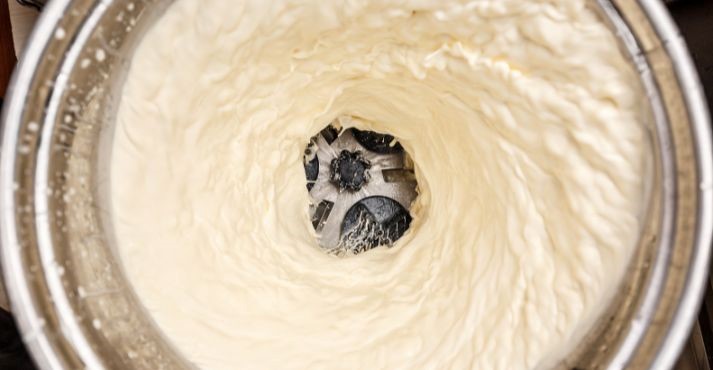Butter is an everyday food staple and a popular dairy product worldwide.
Most butter sold today is from cows’ milk, but butter can also be produced from the milk of sheep, goats, buffalo, and yaks.
Manufacturers and home chefs make butter by churning milk or cream to separate fat from the buttermilk. The result is a smooth, creamy spread ranging from white to deep yellow.
Depending on the temperature, butter can exist in various textural states—liquid, semisolid, or solid. Its unmatched ability to enhance sweet and savory dishes makes it essential for the kitchen.
In baking, butter adds moisture, flavor, and a tender texture to cakes, cookies, and pastries. Meanwhile, butter adds a luxurious richness and depth of flavor to savory dishes, sauces, and roasts.
The demand for butter is rising due to growing preferences for pure and organic food choices. As awareness of health benefits associated with moderate saturated fat consumption increases, the butter market is poised for steady growth.
Current Market Overview

According to Statista, the revenue from the global butter market is expected to reach US$49.91 in 2024, and the market is expected to grow annually by 6.15% (CAGR 2024-2028). With total population figures, per-person revenues of US$6.44 will be generated in 2024.
In global comparison, most revenue is generated in India (US$8,035m in 2024). In the butter market, volume is expected to amount to 4.42bn kg by 2028. The Butter market is expected to show a volume growth of 3.2% in 2025.
The butter market has seen consistent growth in both production and consumption trends. Increased demand for natural and artisanal products has driven production expansion. Consumers valuing butter’s versatility and rich flavor contribute to a rising consumption trend.
Moreover, health-conscious choices and recognizing the benefits of moderate saturated fats fuel its popularity. These trends signify sustained growth for the butter market.
Factors Influencing Demand in the Butter Market

The trends in the dairy sector reveal that the key factors influencing demand and growth in the butter industry include increasing awareness of the health benefits of natural fats, the popularity of butter in baking and cooking, shelf-stable dairy products, emerging markets, rising incomes, and rising consumer demand for organic food options.
- Natural and Authentic Appeal
Consumers seek natural and authentic food products, and butter, a minimally processed dairy item, aligns with this preference.
- Health Benefits of Natural Fats
Natural fats offer crucial health benefits, enabling nutrient absorption and supporting brain health. As awareness grows, consumers seek butter as a wholesome source of essential nutrients.
- Popularity of Butter in Baking and Cooking
Butter’s versatility in enhancing both sweet and savory dishes fuels its global demand, as home cooks and chefs appreciate its rich flavor and texture, making it a kitchen staple.
- Shelf-Stable Dairy Products
The convenience of shelf-stable dairy products, including butter, aligns with modern lifestyles, contributing to sustained demand as consumers prioritize longer shelf life and easy storage options.
- Emerging Markets
In emerging markets, changing consumer preferences and increasing exposure to global culinary trends drive demand for butter as it becomes a desirable ingredient in diverse cuisines.
- Rising Incomes
As incomes rise globally, consumers are willing to invest in premium food products, including butter, due to their perceived quality, flavor, and versatility, leading to increased demand.
- Consumer Demand for Organic Food Options
Rising awareness of health and environmental concerns propels the demand for organic food options, positioning butter as a sought-after natural and organic choice in response to evolving consumer preferences.
- Culinary Applications
The rich and distinctive butter flavor adds depth and indulgence to various dishes, increasing demand.
- Artisanal and Specialty Trends
The rise of artisanal and specialty food trends has boosted demand for high-quality, small-batch butter catering to discerning consumers.
Challenges in Butter Production

Butter producers face several challenges, including rising production costs, environmental concerns, quality control issues, competition from alternative products, and unpredictable milk supply.
Despite these challenges, the popularity of butter’s versatility and deliciousness is expected to drive continued growth in the market.
- Increasing Competition from Other Dairy Products
Butter faces challenges due to the growing popularity of plant-based dairy alternatives, such as plant-based spreads and margarine, which compete for consumer attention and market share.
- Rising Costs of Production
Elevated production costs, attributed to feed prices, labor, and energy, challenge butter producers, impacting profit margins and overall economic sustainability.
- Environmental Sustainability Concerns
The ecological impact of butter production, including deforestation and greenhouse gas emissions, requires attention and mitigation to align with modern sustainability standards.
- Quality Control and Standardization
Maintaining consistent quality and adhering to standardized production processes present ongoing challenges, ensuring that butter products meet regulatory requirements and consumer expectations.
- Fluctuating Milk Supply
Milk supply is disturbed due to weather conditions, and market dynamics create instability in butter production, requiring effective management strategies to balance supply and demand.
Innovations in Butter Production

Butter production involves several steps, including cream separation, pasteurization, churning, and packing. Butter production has seen significant advancements as food technology continues transforming the food and beverage sector.
Technological advancements have revolutionized butter production, emphasizing sustainability and organic practices.
Automated systems monitor and control production, guaranteeing precision and reliability. Sustainable practices, like energy-efficient machinery and eco-friendly packaging, reduce environmental impact.
Organic butter production has seen advancements, with farms adopting precision agriculture, minimizing chemical inputs, and focusing on animal welfare. Cutting-edge equipment allows for precise temperature and moisture control, preserving the natural richness of organic butter.
These technological changes enhance production efficiency and address consumer preferences for sustainably sourced and organic products, positioning the butter industry as modern and eco-conscious, appealing to health-conscious consumers.
The butter market is a dynamic and growing market. As a food importer or manufacturer, you must attend food and beverage exhibitions to stay ahead of the competition and learn about innovations in the industry.
New Products and Varieties
The butter industry players introduce new products and varieties as consumers’ choices evolve. Innovations include flavored, whipped, and functional variations enriched with herbs, spices, or nutritional supplements.
These products meet the demand for unique culinary experiences and healthier options, aligning with modern dietary requirements and food trends.
Artisanal and specialty butter have become popular, featuring unique flavor profiles like truffle-infused, sea-salted, or honey-lavender blends.
These variations allow consumers to enhance their cooking and add distinctive twists to sweet and savory dishes, providing a more diverse culinary experience.
Moreover, butter producers are exploring eco-friendly packaging materials, convenient portion-controlled options, and aesthetically pleasing designs.
Some brands adopt resealable packaging to enhance freshness, while others focus on elegant, minimalist designs to stand out on shelves, maintaining sustainability and visual appeal.
Regional Market Insights

Major butter-producing countries include the United States, India, Germany, France, and New Zealand. The international trade of butter is significant, with countries exporting and importing butter to meet domestic demand or take advantage of price fluctuations in global markets.
- North America
North American consumers prefer unsalted and sweet cream butter products for daily consumption. Cultural influences emphasize butter’s role in baking, seen prominently in the popularity of classic American desserts.
The region also exhibits a growing interest in artisanal and flavored butter, reflecting diverse culinary experiences.
- Europe
With its rich culinary heritage, Europe showcases a diverse range of butter varieties. The renowned Beurre de Baratte, made through traditional churning methods, holds cultural significance in France.
Nordic countries favor salted butter, often paired with bread. Eastern European cuisines incorporate cultured butter, creating a tangy richness to dishes. European consumers appreciate the quality of regional butter produced using traditional methods.
- Asia Pacific
Asia-Pacific butter consumption by country varies. In India, ghee, a clarified butter, is a staple in traditional cooking. Japan and South Korea exhibit a growing interest in butter, with unique blends like yuzu-infused or matcha-flavored gaining popularity.
In China, butter finds applications in traditional and Western-influenced cuisines, reflecting a fusion of culinary influences.
- Middle East and Africa
Local cooking styles influence butter consumption in the Middle East and Africa. In regions like North Africa, clarified butter, known as “smen,” is used for flavoring. Traditional sweets in some Middle Eastern countries often feature clarified butter or ghee.
The diversity in regional cuisines shapes distinct butter preferences, showcasing the cultural traditions and culinary practices.
Health and Wellness Trends
Butter has high nutritional value, health-promoting properties, and great flavor and aroma. The supply of butter in terms of varieties and flavors is changing due to health and wellness trends. Butter producers are considering consumers’ changing dietary preferences.
While moderation is vital, butter provides essential fats and fat-soluble vitamins. The emphasis on quality and sourcing in grass-fed and organic butter options reflects consumer preferences for nutrient-rich choices.
- Grass-fed Butter
Grass-fed butter, sourced from cows primarily fed on pasture, is prized for its higher omega-3 fatty acids and antioxidant content, appealing to health-conscious consumers seeking nutrient-rich options.
- Organic Butter
Organic butter, produced without synthetic pesticides or antibiotics, aligns with clean eating trends. Its popularity grows as consumers prioritize natural, sustainably sourced food products.
- Specialty Butter
Specialty butter, featuring unique flavors or enriched with nutrients, caters to diverse tastes. Whether infused with herbs, spices, or superfoods, this butter offers a premium and customized culinary experience.
Consumer awareness about the nutritional aspects of butter has increased significantly. People are now more informed about the benefits of moderate butter consumption, recognizing it as a source of essential fats and fat-soluble vitamins.
Butter Market Key Players
Small and big companies operate in the butter world, trying to be more creative with their products. The top companies often focus on making new and improved butter items. Many players prefer an acquisition strategy to become bigger and have a more substantial presence in the market.
Some of the key players in the butter market are:
- Fonterra Co-operative Group (New Zealand)
- Arla Foods (Denmark)
- Dairy Farmers of America (U.S.)
- Gujarat Co-operative Milk Marketing Federation (India)
- Ornua Co-operative Ltd. (Ireland)
- Land O’Lakes, Inc. (U.S.)
- Nestle India Ltd. (India)
- Organic Valley Family of Farms (U.S.)
Frequently Asked Questions (FAQs)
What are the types of Butter available in the Market?
There are different types of butter available in the market. Some of the most common include:
- Unsalted Butter
- Salted Butter
- Clarified Butter (Ghee)
- Grass-fed Butter
- European-style Butter
- Cultured Butter
- Whipped Butter
- Flavored Butter
Which regions are leading the Butter Market?
Europe and North America are leading the global butter market, driven by a rich culinary tradition, high consumer demand for quality dairy products, and a diverse range of butter varieties catering to evolving tastes and preferences.
What was the market size of the Butter Market in 2023?
The butter market was valued at US$ 46.8 billion in 2023 and is expected to rise to US$ 67.6 billion by 2033.
Conclusion
Butter has been a staple in many cultures for thousands of years. The shifting consumer preference towards healthy and organic food is a major factor aiding the growth of the global butter market.
European and North American regions continue to dominate, driven by rich culinary traditions. Emerging trends include a specialty and organic butter surge, meeting the demand for diverse and healthier options.
Innovations in production techniques, such as continuous churning, enhance efficiency while packaging evolves to align with sustainability goals. Despite challenges like rising production costs, the butter market is resilient, and there are ongoing efforts to meet evolving consumer expectations.












